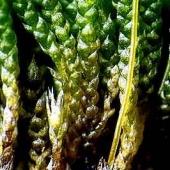Please select root levels for the menu
NZ Plants
Lepyrodon lagurus
Family: Lepyrodontaceae
-
Plants growing on the base of a tree
L Jensen
View picture -
Plants with long slender branchlets (brood bodies)
L Jensen
View picture -
Shoots
L Jensen
View picture -
Leaf detail
L Jensen
View picture -
Early formation of a branch with reduced leaves (flexuose branch)
L Jensen
View picture -
Flexuose branch with reduced leaves
L Jensen
View picture -
Flexuose branches often fragment, acting as brood bodies to give rise to new new plants.
L Jensen
View picture -
Terminal portion of sporophyte with maturing capsule and calyptra cover
L Jensen
View picture -
Basal portion of sporophyte attached to shoot and encircled by bracts (perichaetial bracts)
L Jensen
View picture -
Perichaetial bracts
L Jensen
View picture -
Maturing capsule with calyptra removed exposing the capsule lid (operculum)
L Jensen
View picture -
Mature capsule with peristome
L Jensen
View picture -
The outer peristome is reduced to a low membrane while the inner peristome consists of delicate white teeth.
L Jensen
View picture
Lepyrodon lagurus forms dense, yellow or brown-green mats. Lower portions of stems are covered with a dense tomentum of smooth, brown rhizoids matting the stems together. The upper leaves are 2-3 mm long, oblong, strongly concave; they narrow gradually or abruptly to a flexuose tip (hairpoint). Elongate, slender branches (flagellate branches) with reduced leaves are often formed, which often break off and regenerate new plants. The cylindrical capsule has an outer peristome reduced to a low membrane while the innter peristome consists of delicate pale teeth.
Widespread at higher elevations on moist rock or soil.




